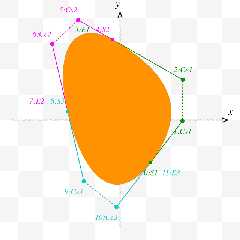|
 |
In fact, it's simple !
Each segment is defined by four points.
First segment :
0 : Point on curve
1 : Control point attached to point (0)
2 : Control point attached to the next point
3 : Next point
Second segment :
4 : Point on curve equal to (3) from previous segment
5 : Control point attached to point (4)
6 : Control point attached to the next point
7 : Next point
... and so on.
In the attached image, the points are numbered and named in accordance
with POV's built-in spline editor : "S. Cs. Ce. E.".
I haven't found what these names correspond to.
The complete curve is therefore the succession of segments placed
end to end.
In the image, each element of each segment has the same color :
Segment 1 - Point 0,1,2,3 - Color Green
Segment 2 - Point 4,5,6,7 - Color Magenta
Segment 3 - Point 8,9,10,11 - Color Blue
Disturbingly, the two pendulums of the same point are identified by two
distinct segments. Once you've got the hang of it, it's no longer a problem.
--
Kurtz le pirate
Compagnie de la Banquise
Post a reply to this message
Attachments:
Download 'drawing_bezier_spline_editor.png' (38 KB)
Preview of image 'drawing_bezier_spline_editor.png'

|
 |
|
 |
On 2024-07-13 09:10 (-4), kurtz le pirate wrote:
>
> In the attached image, the points are numbered and named in accordance
> with POV's built-in spline editor : "S. Cs. Ce. E.".
POV has a built-in spline editor? When did this happen? Is it a
Windows thing?
Post a reply to this message
|
 |
|
 |
On 15/07/2024 19:04, Cousin Ricky wrote:
> POV has a built-in spline editor? When did this happen? Is it a
> Windows thing?
No, it's a Mac OSX feature.
--
Kurtz le pirate
Compagnie de la Banquise
Post a reply to this message
Attachments:
Download 'spline_editor.jpg' (293 KB)
Preview of image 'spline_editor.jpg'

|
 |




![]()